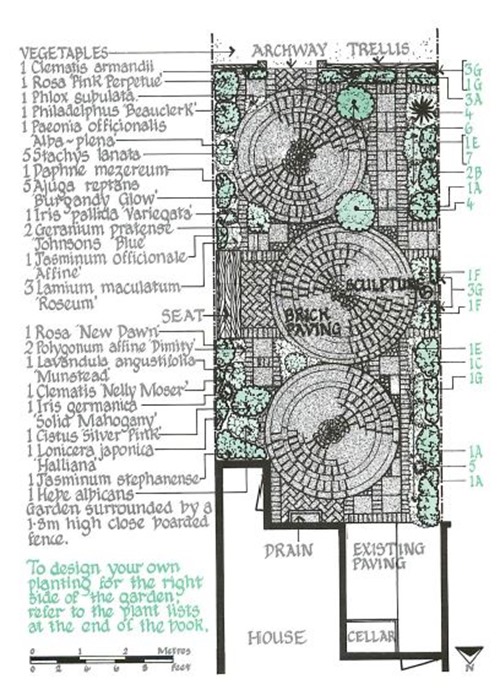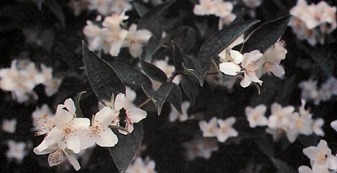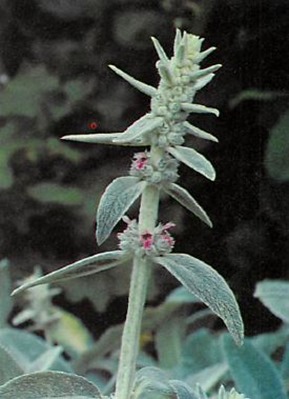





This paved garden is both interesting and exciting for someone who is fascinated by shape and texture, and who doesn’t want to touch a trowel or think about working in the garden once it is laid out and planted.
The garden of this terraced house faces east and is designed in such a way that it is particularly attractive to admire from the first floor window. The amazing swirling path leading to the three brick circles shown on the plan indicates each brick that is needed. Its busy detail is very much in fashion, and good luck to the householder who intends to lay it himself.
As the bricks, stone, paving and cobbles are concentrated in such a small area, the initial outlay will be expensive, but the advantage is that it will be very inexpensive and easy to maintain.
The brick and stone paving can be laid in two different ways. One is to point between the brick or slabs with mortar to keep out weeds; the other is to brush sand between the bricks so that rockery-type plants such as campanula, Aubretia deltoidea and Alyssum saxatile can be encouraged to grow in the cracks and break up the stone work with plants. The disadvantage of the second method is that weeds too can grow between the stones.
 Looking along the garden from the house, an archway against the rear wall surrounded by trellis is deliberately placed to the left of centre, so that the focal point is in front of the house rather than the path which is to the right.
Looking along the garden from the house, an archway against the rear wall surrounded by trellis is deliberately placed to the left of centre, so that the focal point is in front of the house rather than the path which is to the right.
On either side of the second circle is a pleasant sitting arbour surrounded by Jasminum officinale affine and the New Dawn rose. Opposite the sitting arbour is the pleasing view of a statue with Artemisia Powis Castle planted on either side.
Throughout the garden, large pots or containers can be placed to vary the height of planting and break up the paving with colour. Despite the small space, the garden is exciting, interesting and very undemanding.
A built-in barbecue in such a small garden would become too important a feature and take up too much of the planting area around the side. But a portable barbecue can easily be stored round the side of the house on the existing paving area near the dust bins.
Although a shed is always useful, a space has not been allocated for one as garden implements such as a spade and mower will not be necessary in this garden; just a trowel kept in the kitchen drawer should be enough!
The rotary washing line can be fixed into a hole prepared in the centre of the third circle, away from the eating area.
Herbs are a welcome addition to any garden. They are extremely trouble-free plants and grow in terracotta pots on the first circle immediately in front of the house where they’ll get the most sun; behind them the larger herbs such as rosemary, hyssop and sage can be planted in the beds, along with thyme, which is a low-growing ‘woody’ herb.
Despite the fact that this is such a small garden, the varying shapes of beds and planting areas between the paving and along the perimeter of the garden give you plenty of opportunity to plant interesting climbers, shrubs and flowers to break up the stone quality of the garden and bring a lush variety of plants and colour into the space. The planting itself becomes a pattern related to the paving and all the more interesting if a colour scheme of say blue and pink is used.
It is not unusual for small, period terraced houses to be surrounded by 4 ft (1.2 m) brick walls. These can be extended upwards by hard wood trellis or sections of plastic covered wire squares fixed between solid wooden posts set 5 ft (1.5 m) apart, an ideal structure for the climbers, and will quickly make an excellent screen between one property and another. (For other ideas see Fencing.)
T = Trouble free
Shrubs
 T Philadelphia x Beauclerk (Mock orange) Delightful, hardy deciduous summer flowering shrub. Grows to 8ft (2.5m). Spread 5-6ft (1.5-1.8m). Milk white sweet-smelling flowers in June and July. Midgreen leaves. Prune after flowering to keep compact.
T Philadelphia x Beauclerk (Mock orange) Delightful, hardy deciduous summer flowering shrub. Grows to 8ft (2.5m). Spread 5-6ft (1.5-1.8m). Milk white sweet-smelling flowers in June and July. Midgreen leaves. Prune after flowering to keep compact.
Daphne mezereum Deciduous shrub. Grows to 5ft (1.5m). Spread 2-4 ft (60cm- 1.2m). Light green leaves. Sweet-smelling purple/pink, red/violet flowers from February to April followed by scarlet berries, which are poisonous. Prefers sun.
T Lavendula spica ‘Munstead’ Hardy evergreen shrub. Height l-2ft (30-60cm), spread 18 in -2 ft (45-60cm). Lavender blue flower spikes in July to September. Needs to be replaced every 5- 10 years. To keep bushy cut back last year’s growth only each spring. Do not cut back into old wood. Prefers sun.
T Cistus ‘Silver Pink’ (Sun rose). Evergreen shrub. Height 2-3ft (60-90cm). Spread 2-3 ft (60-90cm). Thick green leaves with grey underside. Silver flowers in June-July. Hard-working shrub which earns its place in the garden.
T Hebe albicans Hardy evergreen rounded shrub. Height 2 ft (60cm), spread 2ft (60cm). Slightly fleshy grey/blue leaves, white flowers in June and July.
Clematis armandii Dark evergreen leaves. White flowers April to May. Grows to 30ft (9m). Very open-growing climber that will try to find its way off the wall on to a tree or shrub. Needs shaded roots.
T Rosa Pink Pcrpetue (Climbing rose). Grows to 15ft (4.5m). Has deep to light pink flowers in July and September. Easy and reliable.
Jasminum stephanense Vigorous semi-evergreen (in mild winters) climber. Grows 10-15ft (3-4.5m). Dull green leaves and lovely clusters of pale pink flowers appear in June.
T Jasminum officinale affine (Common white jasmine). Hardy and deciduous vigorous twining climber. Mid-green leaves. Cluster of white sweet-smelling flowers from June to October. Can grow to 30ft (9 m) if you let it.
T Rosa ‘New Dawn’ Climbing rose. Grows to 10 by 10ft (3 by 3m). Repeat flowering, large clusters of pale pink delicate fragrant flowers from June onwards. One of the most disease-resistant roses.
Clematis ‘Nelly Moser’ Deciduous clematis. Height about 12 ft (3.5m), mid-green leaves. Stunning, pale pink/mauve flowers with central carmine strip from May to November.
Lonicera japonica ‘Halliana’ Rampant semi-evergreen twining climber. Height 25—30ft (7.5— 9 m), mid-green leaves. Fragrant pale pink flowers June to July, often creamy when young. Needs training otherwise it soon becomes matted.
Phlox subulata Hardy, herbaceous, dense mat, low-growing plant. Grows no more than 4in (10cm), spread 18 in (45cm). Lavender flowers May and June. Mid-green leaves.
T Paeonia officinalis ‘Alba Plena’ Hardy herbaceous perennial. Very pale pink flowers May and June. When in flower height about 2ft (60 cm). Large dark green leaves. Divides well. Dies down in winter, but is certainly impressive when in flower.
 T Stachys lanata (Lambs’ Ears). Hardy low-growing herbaceous perennial. Soft grey/green woolly/furry leaves. Good summer ground cover, easily divided and excellent for the edge of a border or bed. Purple flowers on woolly spikes in July. Height 1 ft- 18 in (30-45 cm). Prefers sun.
T Stachys lanata (Lambs’ Ears). Hardy low-growing herbaceous perennial. Soft grey/green woolly/furry leaves. Good summer ground cover, easily divided and excellent for the edge of a border or bed. Purple flowers on woolly spikes in July. Height 1 ft- 18 in (30-45 cm). Prefers sun.
T Ajuga reptans ‘Burgundy Glow’ Wonderful evergreen ground cover. Oblong green/burgundy leaves. Blue flowers in June and July. Grows between 4in (10cm) and 1 ft (30cm). Likes shade.
T Iris pallida ‘Variegata’ Tall, hardy bearded iris. Prefers sun. Can grow to 3 ft (90cm). Lavender blue flowers May and June. Good plant to vary foliage.
T Lamium maculatum ‘Roseum’ Excellent ground cover. Herbaceous perennial. Good in shade. Grows to 9 in (22.5cm). Mid-green leaf with silver stripe and pink flowers in May. Prefers shade.
T Geranium ‘Johnsons Blue’ Hardy herbaceous perennial – not the same as pot plant geranium (Pelargonium) that grows in pots on window sills! Grows to 1 ft (30cm). Delicate blue flowers throughout the summer and prettily divided leaves. Good summer ground cover in sun or shade.
T Polygonum affine ‘Dimity’ Height 6-9in (15-22.5cm), spread 18 in (45cm) or more. Narrow dark green leaves. Dainty pink flower spikes from July to September, which turn deep red as they mature.
Iris germanica ‘Solid Mahogany’ (Bearded iris) Evergreen foliage, height 2-3ft (60-90cm). Mid-green leaves. Unusual, deep red/brown mahogany scented flowers in early May. Likes sun.
Copyright © www.100flowers.win Botanic Garden All Rights Reserved